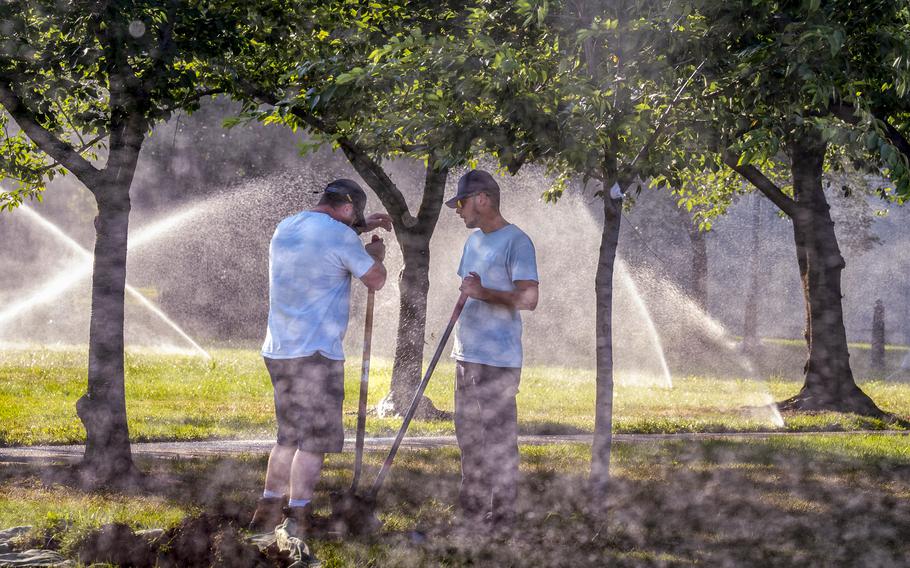
Workmen with the Architect of the Capitol office, perform maintenance on the irrigation system in a park near the Senate, at the Capitol in Washington, Tuesday, June 18, 2024. Extreme heat is expected to break records for tens of millions of people in the United States this week. (J. Scott Applewhite/AP)
Unlike other natural disasters, extreme heat doesn’t topple buildings, flood streets or turn road signs into missiles. It doesn’t provide a dramatic backdrop for daredevil weather reporters. What it mostly does is kill people, quietly and efficiently.
It’s long past time we respect its destructive power, which will only grow as a warming planet makes heat waves more frequent and intense.
This discussion is particularly relevant this week, as a “heat blob” that has punished Mexico and the Southwestern U.S. for months creeps into the Midwest, Northeast and Canada, subjecting possibly 150 million people to unseasonably high temperatures for a miserable stretch of days.
For many Americans, a heat wave is just a nuisance. We’ll sweat through our work clothes and blow out our power bill running the air conditioning. Roads and sidewalks will buckle. Amtrak and public transportation around New York City will lose their spotless reputations for reliable performance (yes, that was sarcasm) as railroad tracks warp and power lines sag.
But for hundreds of thousands of people around the world every year, heat is deadly. In the U.S., it takes more lives than hurricanes, tornadoes, earthquakes or floods. It contributed to the deaths of more than 2,300 Americans last year, according to the Centers for Disease Control and Prevention, the most in 45 years of record-keeping. The number of such heat-related deaths has more than doubled in just the past five years.
Though this week’s heat wave will have all the hallmarks of a discrete natural disaster like a named hurricane or serious earthquake, including the threat to human life and health, the Federal Emergency Management Agency will not treat it as such. That’s because it doesn’t consider heat waves or wildfire-smoke events “major disasters” worthy of federal relief.
This is a huge oversight. On Monday, the Center for Biological Diversity, along with the AFL-CIO, the Service Employees International Union and dozens of other unions, public-health groups and nonprofits, petitioned FEMA to change its policy. The agency should listen. “Major disaster” designations for heat and smoke would unlock federal relief money for local governments to prepare for hot weather and wildfire-smoke season by building cooling centers, upgrading public buildings, communicating with the elderly and other vulnerable people, and much more. This would save countless lives and billions of dollars in health care costs and lost productivity.
California spent $800 million on such preparation in 2022, the petition notes. That same year, FEMA rejected the state’s request for federal disaster relief after a heat wave that killed an estimated 395 people. California, like other states, must balance its budget every year and has limited funds for such spending.
The federal government is under no such constraint. FEMA itself is currently underfunded, understaffed and confusingly organized. But Congress can help remedy that, and President Joe Biden can (and should) restore FEMA to its former Cabinet-level position to emphasize its growing importance.
Hotboxes like Phoenix that live with the constant threat of extreme temperatures have tried to become more resilient on their own, but the money is tight and the deaths have kept rising. And such places aren’t always the most vulnerable when climate change causes more and deadlier heat waves that increasingly tend to hang around like unwelcome house guests. The heat dome that camped over the Pacific Northwest in 2021 killed an estimated 1,400 people in the U.S. and Canada in a region where most people didn’t have AC.
The highest temperatures in this week’s heat wave might be in New England, with New Hampshire possibly hitting 101 degrees Fahrenheit. Parts of Canada will get into the 90s. Such places are high on lists of havens from global heating as the zone of human habitability shifts northward in the coming decades. But this week will be a reminder that even these places won’t escape the reach of climate change.
Some have argued we should name heat waves like hurricanes to raise awareness. Meteorologist Guy Walton names them after fossil-fuel companies; the heat blob currently menacing the U.S. is Heat Wave Exxon. It’s a compelling idea, though the World Meteorological Organization argues that naming heat waves would only confuse people. For now, the most immediate heat-wave solution is not clever taxonomy but more urgency and more money.
Mark Gongloff is a Bloomberg Opinion editor and columnist covering climate change. This column does not necessarily reflect the opinion of the editorial board or Bloomberg LP and its owners.